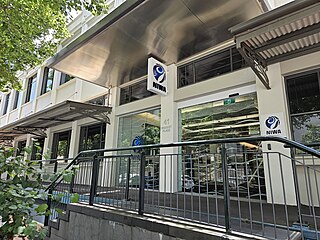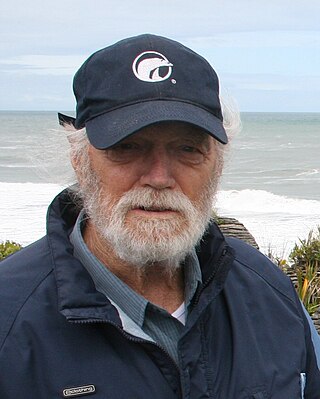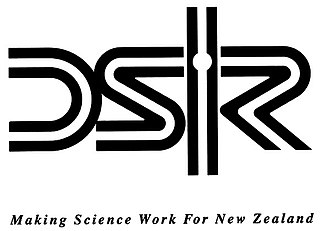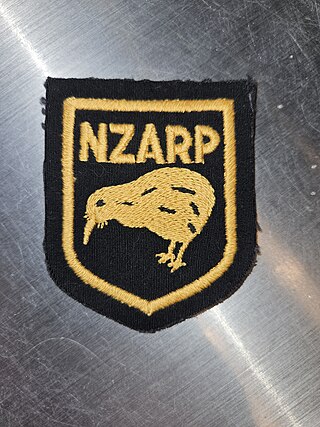In New Zealand, Crown Research Institutes (CRIs) are corporatised Crown entities charged with conducting scientific research.

GNS Science, officially registered as the Institute of Geological and Nuclear Sciences Limited, is a New Zealand Crown Research Institute. It focuses on geology, geophysics, and nuclear science.

Landcare Research is a New Zealand Crown Research Institute whose focus of research is the environment, biodiversity, and sustainability.

The National Institute of Water and Atmospheric Research or NIWA, is a Crown Research Institute of New Zealand. Established in 1992, NIWA conducts research across a broad range of disciplines in the environmental sciences. It also maintains nationally and, in some cases, internationally important environmental monitoring networks, databases, and collections.

David McNiven Garner was a New Zealand research physicist, with a focus in physical oceanography and ocean circulation.

New Zealand wine is produced in several of its distinct winegrowing regions. As an island country in the South Pacific Ocean, New Zealand has a largely maritime climate, although its elongated geography produces considerable regional variation from north to south. Like many other New World wines, New Zealand wine is usually produced and labelled as single varietal wines, or if blended, winemakers list the varietal components on the label. New Zealand is best known for its Marlborough Sauvignon Blanc, and more recently its dense, concentrated Pinot Noir from Marlborough, Martinborough and Central Otago.
The Cawthron Institute is New Zealand's largest independent science organisation, specialising in science that supports the environment and development within primary industries. Cawthron has its main facilities in Nelson. It works with regional councils, government departments, major industries, private companies, and other research organisations throughout New Zealand and around the world. Cawthron employs approximately 300 scientists, laboratory technicians, researchers and specialist staff from 26 countries. It has both chemistry and microbiology labs, and has a major focus on food related testing for food safety and export certification. Cawthron holds IANZ accreditation for a wide range of tests. Its scientists include experts in aquaculture, marine and freshwater resources, food safety and quality, algal technologies, biosecurity and analytical testing.

The Department of Scientific and Industrial Research (DSIR) was a government science agency in New Zealand, founded in 1926 and broken into Crown Research Institutes in 1992.

Frances Elizabeth Somerville Alexander was a British geologist, academic, and physicist, whose wartime work with radar and radio led to early developments in radio astronomy and whose post-war work on the geology of Singapore is considered a significant foundation to contemporary research. Alexander earned her PhD from Newnham College, Cambridge, and worked in Radio Direction Finding at Singapore Naval Base from 1938 to 1941. In January 1941, unable to return to Singapore from New Zealand, she became Head of Operations Research in New Zealand's Radio Development Lab, Wellington. In 1945, Alexander correctly interpreted that anomalous radar signals picked up on Norfolk Island were caused by the sun. This interpretation became pioneering work in the field of radio astronomy, making her one of the first women scientists to work in that field, albeit briefly.

The New Zealand Antarctic Research Programme (NZARP) was a research programme that operated a permanent research facility in Antarctica from 1959 to 1996. It was created by the Geophysics Division of New Zealand's Department of Scientific and Industrial Research (DSIR), originally based in Wellington. The programme promoted research in geochemistry, zoology, geology, botany, meteorology, and limnology.

Norman Hargrave Taylor was a New Zealand teacher, soil scientist and scientific administrator. He was born in Auckland, New Zealand, in 1900. He was the director of the Soil Bureau and was appointed an Officer of the Order of the British Empire in the 1960 Queen's Birthday Honours.

Ernest Mervyn Taylor (1906–1964) was a notable New Zealand engraver, commercial artist and publisher. He was born in Auckland, New Zealand in 1906 but primarily lived and worked in Wellington, New Zealand until his sudden death at the age of 58.
Elsa Beatrice Kidson was a New Zealand soil scientist and sculptor.
William Maxwell Hamilton was a New Zealand agricultural scientist and scientific administrator. He joined the Department of Scientific and Industrial Research (DSIR) in 1936 and led the organisation from 1963 to 1971, turning it into an internationally recognised research institute during his career.
John Davidson McCraw was a New Zealand pedologist, academic, and local historian, particularly of the Central Otago area. The McCraw Glacier in Antarctica is named for him.

Gillian Shirley Wratt is a New Zealand botanist and science administrator. She was the first woman director of the New Zealand Antarctic Programme (1992–1996) and made a Member of the New Zealand Order of Merit for services to Antarctica.
Morice Fieldes was a New Zealand soil chemist and science administrator. He worked initially at Chemistry Division, DSIR, before moving to Soil Bureau, where he rose to be director. The New Zealand Society of Soil Science has an award in his memory.
Kevin Russel Tate was a New Zealand soil chemist, ecologist and climate scientist.

Brian Peter John Molloy was a New Zealand plant ecologist, conservationist, and rugby union player.
Elizabeth Alice Flint was a New Zealand botanist who specialised in freshwater algae. She co-authored the three-volume series Flora of New Zealand Desmids in the 1980s and 1990s.













